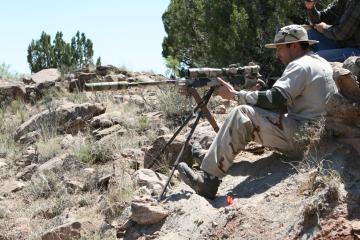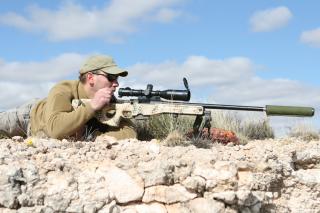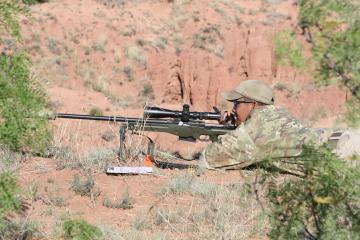
 Ray Sanchez tries to get into the most stable position as quickly as possible. Efficiency of
movement is critically important with sometimes tight time constraints.
Dave Wheeler's Blue Steel Ranch property is located at 4000' altitude, populated with scrub brush
and riddled with gullies and great sweeping ridge lines, which provides fantastic locations for both
shoot positions and tricky target placement. While the travel time from station to station is not
timed, the rough, steep terrain and often-brutal weather tax the shooter physically. Temperatures
between 90 and 100 degrees are common. This year the winds were challenging as usual at 5 to 25 mph
with frequent changes. The temperatures were moderate for the region at 80-90 F.
The stage procedure proscribed that shooters come to each station blind, with no notion of where the
targets will be located. The range officer (RO) read the written brief from the stage description,
and then the shooter had five minutes to locate the targets, identify them to the RO, do range
estimation, dope the wind, and make the shot. Each target gets one shot, and that's it-- no alibis,
no sighters. The shooter earns one point for each target located and identified, one point for each
normal target hit, and three point for each bonus target hit. Many of the stages require some
movement to re-engage the same targets again after moving up to ten yards from the original shoot
position. Targets on the field courses were generally six or twelve inches across, and were placed
as far as 800 yards.

 The author usually competes with an Accuracy International AW in .260 Remington. Shown here is the
.308 he used to "shoot in" and verify the stages earlier in the week.
I didn't get to shoot the Steel Safari as a competitor this year, although I did "shoot in" both
field courses the preceeding week. It is common practice for match
staff to "shoot in" stages while finalizes the stage setups. The purpose is to find any final
problems with shoot positions, target positions, terrain or organic features, and correct them to
ensure safety and that each competitor has a fair challenge. Since I wasn't shooting for score and
to save my "good" ammunition, I shot my .308. Here's a brief overview of my setup. Accuracy
International AW in .308 with a S&B PMII 3-12x50 mm scope, AI bipod, and Thunder Beast Arms model
30P sound suppressor. I use the Swarovski Laser Guide range-finder and typically get by without
using binoculars (if I need them, I have a set of Leica Ultravids). In .308, I shoot the 155 Lapua
Scenar. The competition rifle I used at the 2006 and 2007 Steel Safari matches is the exact same
rifle, but set up in .260 Remington and shooting the 139gr Lapua Scenars.
This year the wind conditions were challenging - especially for .308 shooters. While fast, high-BC
6.5 and 7 mm cartridges can get away with "edge of plate" holds in 5-15 winds, the .308 shooter has
to be on top of his game. A rolling wind change can just turn a 6-round stage (on 6 different
targets) into a distaster. On the other hand, the moderate and changing winds made the 80-90 F
temperatures feel comfortable and heat itself was not a huge problem like it was in 2008.

 The Steel Safari puts rifles and shooters to the test.
The match also tests gear. Over the course of the match, rifles just keep getting dirtier and the
wind blows fine dust and sand just about everywhere. This tests the reliability of rifles and
other gear in field conditions.
A variety of rifles, calibers, and scopes were used at the match, however, each competitor had a set
of more or less similar gear. First, an accurate rifle critical. Bench-rest accuracy is not
required; one MOA is sufficient, one-half preferred. Almost everyone is using their own hand-loads
with premium bullets from Sierra, Berger, or Lapua. Ballistic data, or "dope," completes the triad
with the rifle and ammunition. Most shooters laminate a small card and tie it to their rifle or
scope, or use a retractable "pathfinder" available from Allison Machine Tool or Leupold. Long-range
ballistic data isn't useful unless the target distances can be determined, and the best tool for
that is a laser range-finder. Since many laser range-finders are monocular units with limited field
of view, a good set of binoculars can be a life-saver when trying to find that hidden target. Just
about everyone uses a bipod on the rifle, except for the shooters in light rifle class whose rifle
could not "make weight" with one installed.
Next is a set of shooting sticks, and a rear bean-bag to
help stabilize the butt of the stock while shooting prone. Water is critical because the shooters
are on the course for about six hours, and an apple or a Powerbar aren't a bad idea either. Throw
everything in a pack and you're set.
|